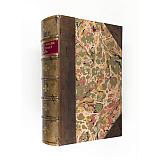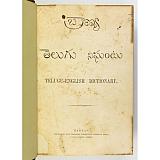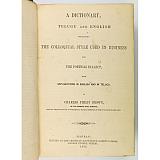From the learned pandit to the illiterate prisoner: the first Telugu-English dictionary, by the "Saviour of Telugu"
A Dictionary, Telugu and English,
explaining the colloquial style used in business and the poetical dialect, with explanations in English and in Telugu. [with] A Dictionary of the Mixed Dialects and Foreign Words used in Telugu. With an explanation of the Telugu alphabet. Madras printed at the Christian Knowledge Society's Press 1852, 1854
First editions, two works bound in one. Small 4to, 25 x 17 cm; pp.[iv, half-title and advertisements], xvi, 1303, [1, blank]; [iv, half-title and advertisements], xxviii, 131, [1, blank]. With contemporary advertisements. A very good set bound in modern half speckled calf over marbled boards. Spine label and compartments in gilt. Appendix of the first volume has 'APPENDIX' faintly printed on fore-edge. Discreet binders ticket to rear end-paper. Half-title of first volume spotted with 1cm tear to upper inner margin. Single wormhole to outer margin pp.75-131 of second volume, not affecting text.
The first Telugu-English dictionary by Charles Philip Brown (1798-1884), still considered the standard English study of the classical language. Brown, also known as Andhrabhashoddhaaraka or " saviour of Telugu", was the also the first to translate works of Telugu literature, such as The Verses of Vemana (1829), into English. Holding the lucrative position of Postmaster General of Madras, Brown was supported by a 'college' of pandits in his prolific production of linguistic works and editions of Telugu literature. In the preface of the first work he describes the wide range of lexical sources he encountered during his twelve years as a magistrate: "I had intercourse with all classes, from the learned pandit or raja, to the illiterate prosecutor or prisoner. Tradesmen, doctors, hunters and sailors, poets and painters all became my instructors as they fell in my way". The second work, intended as a supplement to the 1852 dictionary, focusses on loan words from other languages into Telugu: "the modern Telugu contains a variety of Persian and Arabic expressions. In later years, some English words have crept into use". This work shows Brown's impulse to separate what he regarded as 'pure', indigenous Telugu from foreign accretions. Brown had published his companion volume, A Dictionary, English and Telugu explaining the English idioms and phrases in Telugu, also in 1852.





